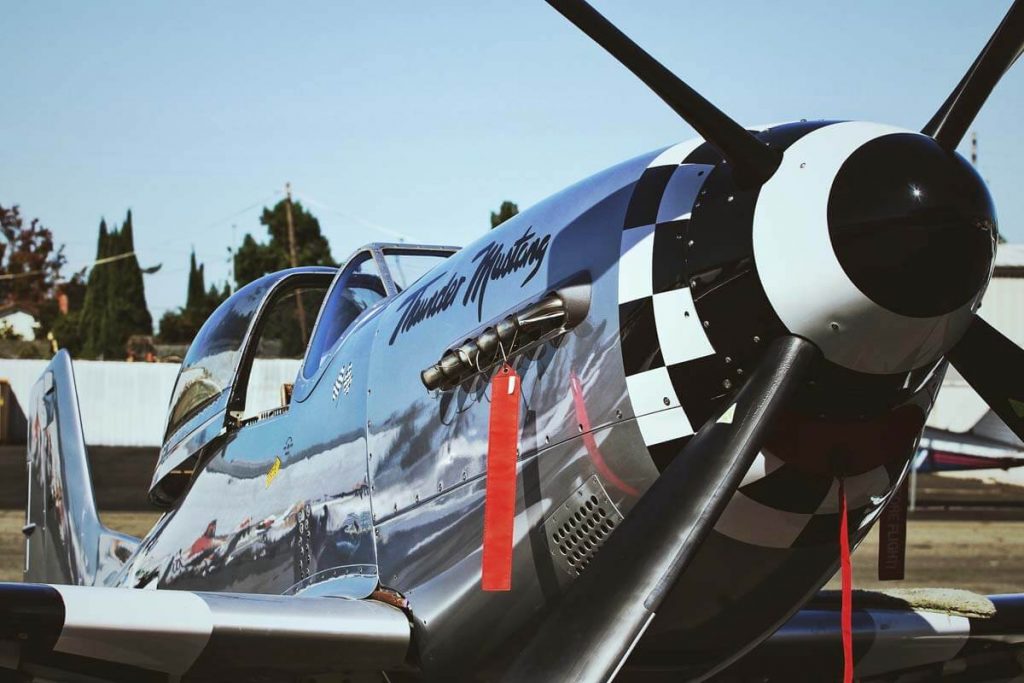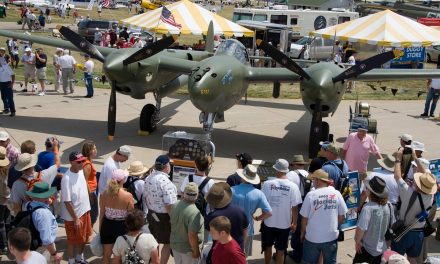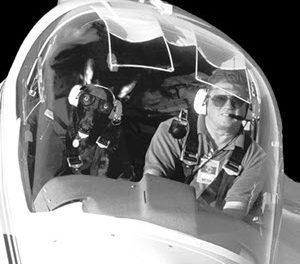
Photo by Chris Leipelt
The sound is unmistakable.
Today, I’d recognize that sound in the first two seconds, but 50 years ago, it was totally alien to me. It was high-pitched and guttural at the same time; the smooth, even roar of a gasoline-powered monster, a 1,650-hp supernova on a leash.
The first time I heard it, I was busy finding and putting out root fires far north of the Arctic Circle in Alaska, about 300 miles from any place with a name you might recognize. (You have heard of Anaktuvuk Pass, haven’t you?) I was part of a fire crew mopping up after a forest fire in the southern Brooks Range. It was about 9 p.m., but the sun was still up, apparently delighted at shining all day and what would normally be all night.
The fierce sound grew in intensity, mechanical love made audible, even more so when its source became obvious. It was a 12-cylinder Merlin engine, busily converting fuel to noise in a P-51 Mustang, coming straight at me. The pilot was flat-hatting at about 50 feet AGL, probably terrifying the local Grizzlies and Caribou and happily consuming sky at perhaps 350 mph.
“Thank you, God” I thought, as the Mustang sliced past me and pulled up into a glorious chandelle, then dived back down for another pass. It didn’t go unnoticed that the entire airplane was painted bright pink, and I caught a flash of the name Pink Lady stenciled beneath the barely PG-rated nose art.
For a college kid on summer vacation from the University
of Alaska, the Pink Lady was a brief but welcome respite from a 12-hour day of hard work. I was looking for wisps of smoke in the above-ground root structure of burned-out trees in the permafrost of the local muskeg. One of four students who’d elected to fight fires May through late September, I was trying to scratch up enough money to pay for the fall semester.
I learned later that this particular Mustang had been sold as surplus after World War II, then was somehow reacquired by the government when the Bureau of Land Management needed a recon airplane to help coordinate firefighting. The bureau had about a dozen airplanes at work during the summer fire season, mostly amphibious singles and twins dedicated to positioning fire crews as close as possible to fires.
The Mustang helped coordinate with base on crew and equipment needs, and because it was so fast, it could oversee three or four fires a day to help locate hot spots, relay requests for additional equipment or personnel, and generally position and help manage the needs of fire-fighting crews. If the bureau needed more range, the airplane had hard points beneath the wings to mount aux tanks.
Over the next three months, I hung around the Fairbanks fire base in hopes that I might find an opportunity to snag the rear seat on a flight. I almost made it, too. The guy who was supposed to fly observer in the Mustang’s rear pit was sick one day, and the bureau preferred to have someone in the Pink Lady’s rear seat who knew a little about aviation. I knew as little as anyone, so I stepped up and volunteered. Sadly, the regular observer showed up a few minutes before launch and refused to accept my offer of $50 to discreetly return home and nurse his cold. Bummer.
Like most civilianized Mustangs, Pink Lady had the rear 85-gallon fuselage tank removed and a tiny, suitably uncomfortable seat installed in its place, no engine or flight controls in back. Just radios, a shoulder harness and a narrow, tapering, bubble canopy to bump your helmet against during one of the best rides you could ask for.
I saw Pink Lady perhaps a dozen times over those three summers, and the pilots always gave us ground-pounders a mini-air show, mostly because we were in the middle of nowhere, and there was no one around to tell them they couldn’t. Most of the pilots were also war surplus, and they were overjoyed to be allowed to fly a properly maintained Mustang without being shot at.
With support from the P-51, a few ratty DC-3s, three tired and rusty Grumman Gooses (Geese?), a handful of Cessna 180s on floats, and a few other marginally airworthy machines that were older than their pilots, fire crews could stay on scene for up to 10 days, the bureau’s legal limit, and boy, were we ready to come home after 10 days in the boonies.
Airplanes handled practically every mission in the Alaskan bush, sometimes para-dropping supplies or smoke jumpers, often transporting firefighters in to the nearest lake, river, or stream (and occasionally, even getting back out without breaking anything), hauling provisions and beer to a tired team in the truly shaggy tundra, and performing other tasks you might not believe. We were frequently amazed at what the Bureau of Land Management airplanes and pilots could do.
Fighting forest fires in Alaska was a little different than in the lower 48. We had no on-scene air support from tankers of any kind, and the dedicated, Canadair CL-215 water bomber was still 10 years in the future, quietly gestating in some designer’s brain. The Navstar satellite system (better known as GPS) was also far in the future, so directions to a “smoke” were usually simple; fly 11 miles west of the village of Chiginook and look for the bend in the east/west creek.
There were probably less than 1,000 miles of paved highways in Alaska at that time, but there were many thousands of miles of dirt. During summer after the seasonal rains had come and gone, dust from those roads covered everything. Conversely, most of the ground was permafrost below about a foot or two, so the thaw of late spring/early summer would leave standing water everywhere.
Add to that the fact that the trees had figured out their roots couldn’t grow vertically down through the permafrost, so the pathway toward Nome, was under snow and frozen solid. For most of the rest of the year, the Iditarod trail would be a near-impassable quagmire of muskeg (tundra and melt water), unusable by dogsleds.
Twenty mushers and 150 dogs relayed the serum over five days, fighting near white-out blizzard conditions and dangerously cold temperatures. Collectively, the mushers and their dogs saved the town of Nome and its outlying villages from an epidemic. The lead dog on the final leg of the relay into Nome, Balto, is honored with a bronze statue in Central Park, New York City.
Today, of course, getting to Nome isn’t the challenge it was 90 years ago. Alaska Airlines operates Boeing 737s on a regular schedule, and bush pilots use Nome as a popular base for traveling around the western portion of the state.
Airplanes are involved in practically every aspect of life in Alaska, and that includes the Iditarod race. A fleet of ski-equipped aircraft are stationed along many of the 39 checkpoints of the Iditarod to provide logistic and veterinary support to the contestants and their dogs, plus keep watch over the race in case of emergencies. Veterinarians are stationed at every checkpoint, and others are on call at vet hospitals near the route. Mushers are required to make a total of three rest stops, two for 8 hours each and one for 24 hours.
Support aircraft range from de Havilland Beavers and Twin Otters to the inevitable workaholic Piper Super Cubs and Aviat Huskies. Perhaps surprisingly, even a 90-pound husky or malamute can be partially anesthetized, loaded aboard a Cub or Beaver, and flown out to a nearby veterinary hospital.
Competitors pay a $4,000 fee to enter the race and must qualify by participating in several of Alaska’s other sled dog races before they’re cleared to enter the Iditarod. First prize is around $50,000, and the remainder of the field splits another $300,000.
Virtually all mushers now carry satellite phones, and since checkpoints are usually no more than 50 miles apart, ski-equipped rescue aircraft are less than an hour away if a dog tears a cruciate or meniscus and needs transport to a hospital directly from the bush.
Veterinarians also caution mushers not to run the dogs too hard so that they breathe in supercooled air, frozen to minus 34 degrees Celsius (minus 30 degrees Fahrenheit) or less. Frosted lungs can kill a dog or a human.
Similarly, a typical sled dog can burn as much as 10,000 calories a day, so a musher needs to stay ahead of their energy requirements by feeding them regularly on the trail or at the rest stop.
Back in the ’50s, downtown Anchorage was always the starting line of the race. Early every March, we looked forward to the jubilant sound of perhaps 500 huskies, eager to test themselves against the elements. They could be heard everywhere in town, and those of us with a penchant for their canine poetry always characterized their yodeling howls as the voice of Alaska.
I lived on Third Avenue in those early days, and we could hear the howling for their breakfast or dinner in the days leading up to events leading up to the start of the Iditarod.
Sadly, global warming has recently robbed Anchorage of snow in early March, but the city now trucks in snow from the nearby Chugach Mountains for a ceremonial celebration of the Iditarod’s start. The real starting line is somewhere to the north, sometimes as far north as Fairbanks, 300 miles north.
I moved south many years ago, but it seems there’s always been a husky in my life. Huskies, and dogs in general, have become steadfast friends, and many of them even condescend to fly with me.
My current 90-pound buddy is the most agreeable animal I’ve ever known. He loves to fly, probably because he’s not confined to a canvas bag. He doesn’t complain too much if I make mediocre landing, and like all dogs, he’s great company, once you learn his differences.
Dogs see with their nose, they say “Thank you” with their tongue, they laugh with their tail, and they love with all their heart.
If anyone ever doubts there is a God, they need to look no further than a dog.





